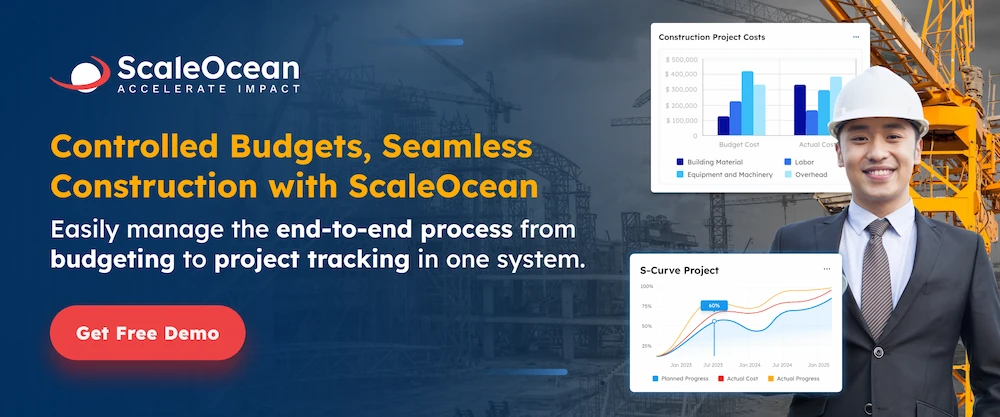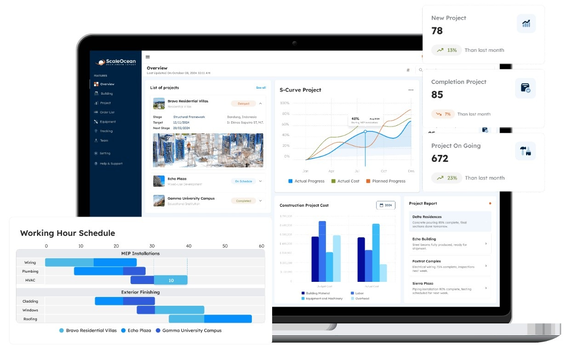Construction asset management (CAM) is critical for improving operations, lowering costs, and extending asset life cycles. It guarantees that equipment, tools, and machinery are properly maintained, used efficiently, and in accordance with rules. In Singapore, where the building sector is rapidly expanding, installing good CAM is critical to remaining competitive. According to Business Wire, the industry is predicted to increase at a 5.5% CAGR between 2024 and 2028, with construction production reaching SGD 20.08 billion by 2028, indicating significant development potential.
This article investigates the advantages of construction asset management, namely how it enhances efficiency, decision-making, and compliance. It also discusses best practices for asset management and the role of technology in improving performance, enabling businesses to make educated decisions while maintaining control over their assets throughout their lifecycle.
- The benefits of CAM (Construction Asset Management) include boosting productivity, improving decision-making, ensuring regulatory compliance, and extending asset lifespan.
- Best practices for CAM include assigning assets to specific users and job sites, using barcodes and QR codes for easy tracking, scheduling maintenance to prevent issues, and regularly monitoring asset performance.
- Effective implementation of CAM strategies involves using technology like CAM software for real-time tracking and integrating with existing systems.
- ScaleOcean’s software provides comprehensive management of construction assets, from preventive maintenance to full lifecycle management. Its features improve efficiency, reduce downtime, and extend asset life, helping businesses optimize asset performance throughout the project.

1. What is Asset Management Construction?
Construction asset management (CAM) is a comprehensive strategy to manage and sustain assets throughout the construction process. It entails the systematic monitoring, maintenance, and optimization of physical assets such as machinery, tools, and equipment to ensure their continued functionality and efficiency. Construction businesses can improve efficiency by employing effective CAM tactics that maximize asset use, reduce wasteful costs and downtime.
CAM uses advanced technology, efficient processes, and industry best practices to monitor asset performance. This approach enables construction site company to make data-driven decisions about equipment upkeep, replacement, and utilization. Companies that remain ahead of maintenance schedules and ensure assets are in peak functional condition can improve project outcomes, eliminate operational disruptions, and increase overall construction project efficiency.
2. Benefits of CAM Construction Asset Management
Construction asset management (CAM) offers various advantages to construction organizations. Businesses that use successful CAM techniques can increase productivity, maintain regulatory compliance, make better decisions, and extend the life of their assets. These advantages not only improve operational performance but also help to ensure the overall success of construction projects.
a. Efficiency
CAM improves operational efficiency by minimizing downtime and expenditures. When assets are monitored and maintained on a regular basis, unexpected breakdowns can be avoided, preventing project delays that might otherwise occur. This proactive approach enables businesses to prevent costly repairs, manage assets more effectively, and keep projects on track, resulting in increased overall productivity. Timely maintenance also increases equipment reliability, resulting in more efficient project execution.
b. Compliance
In the construction industry, regulatory compliance is crucial. CAM helps organizations stay compliant by keeping relevant data, such as equipment maintenance and certifications, and managing contract renewals. Maintaining compliance with these commitments is critical for avoiding fines or legal troubles, especially when operating in a sector with stringent safety and environmental standards. This also helps organizations retain a great reputation and minimize project delays caused by regulatory obstacles.
c. Decision-making
CAM provides firms with detailed information about asset performance, value, and maintenance requirements. This visibility improves decision-making by allowing managers to prioritize asset maintenance, replacement, or repairs based on real-time data. Understanding asset conditions enables construction organizations to make informed budgeting decisions, invest in new equipment, and optimize their resources for the greatest results.
d. Asset Lifespan
One of the primary benefits of CAM is that it extends the life of assets through proactive maintenance. Companies may ensure that their equipment remains in good working order for longer periods of time by arranging regular maintenance and keeping track of service contracts. This eliminates the need for premature replacements, lowers repair costs, and increases the return on investment for each asset.
Also Read: 12 Best ERP Modules for Construction Companies in Singapore
3. Construction Asset Management CAM Best Practices
Effective construction asset management is crucial for increasing operational efficiency, lowering costs, and prolonging asset lifespans. Adopting best practices for asset management allows construction organizations to track, maintain, and maximize their resources. A detailed cost breakdown structure helps businesses manage expenses more effectively, maintain smooth operations, prevent downtime, and increase overall project performance. The following are some significant best practices in construction asset management that can help you reach your goals.
a. Assign Assets to Users, Job Sites, and Vehicles
One of the most important best practices in construction asset management is assigning assets to specific users, job locations, and vehicles. This strategy improves accountability by associating each asset with a responsible entity or location, simplifying tracking and monitoring. When assets are assigned to specific teams or project sites, it is easier to measure their utilization, prevent theft, and assure correct upkeep.
b. Use Barcode and QR Codes to Simplify Asset Lookups
Implementing barcodes and QR codes for asset tracking increases efficiency by simplifying the lookup process. Scanning these codes gives you fast access to essential asset information including maintenance schedules, ownership, service history, and location. This technology lowers manual errors, speeds up inventory audits, and allows for real-time tracking, making it easier to manage assets across huge building projects.
c. Schedule Maintenance Notifications to Extend Equipment Life
Maintenance notifications should be scheduled to ensure that assets are serviced on time, which can extend their operational life. Companies may stay proactive in maintenance by establishing reminders for routine inspections, repairs, and service. This helps to prevent unexpected malfunctions, lowers the need for expensive emergency repairs, and ensures that equipment runs smoothly throughout its useful life.
d. Track Asset Performance and Progress
Monitoring asset performance and progress is critical for maximizing asset utilization and spotting any issues that may impede operations. Companies that analyze how assets function in real time on a regular basis can gather data on their effectiveness, identify underperforming assets, and make adjustments as needed. This method enables firms to take a more strategic approach to asset management, resulting in increased operational efficiency and reduced downtime.
e. Use Asset Kitting to Bundle Equipment Together for Rapid Actions
Asset kitting is a method in which the appropriate equipment and tools are packaged together for certain operations. This strategy enhances operational efficiency, particularly on big building sites, by ensuring that teams have timely access to all necessary supplies. Instead of hunting for individual products, workers may simply grab a kit containing everything they need for a certain operation, saving time and lowering the danger of losing critical tools.
f. Use Contract Management to Track When Contracts Are Set to Expire
Contract management is essential for keeping all service agreements, warranties, and maintenance contracts up to date. Companies can minimize gaps in service coverage by keeping track of when contracts are about to expire, ensuring that their assets are fully serviced. Effective contract management also aids in budgeting by allowing businesses to forecast renewal expenses and ensuring timely contract renewals for continuous service and support.
4. Tips for Effective Construction Asset Management

Effective construction asset management is critical to maintaining the optimal performance and longevity of assets during a project. To achieve this, businesses must use tactics that prioritize accuracy, efficiency, and proactive decision-making. The following are some important ideas for efficiently managing construction assets:
a. Regularly Audit Assets
Regular audits are critical for keeping accurate records of all assets. Companies can detect differences between actual assets and system records by examining the physical inventory on a regular basis. This helps to prevent asset misplacement, ensures that equipment is properly accounted for, and reduces the danger of untracked assets being neglected for maintenance or replacement.
b. Invest in Employee Training
To be effective, an asset management system requires staff to be properly trained on how to use the tools and software involved. Investing in training ensures that employees are knowledgeable about asset management systems, allowing for more accurate data entry, effective tracking, and proper utilization of maintenance plans. A well-trained crew is vital for maximizing the potential of asset management systems.
c. Centralized Asset Management
A centralized asset management system, often facilitated by CMMS facilities management software, streamlines the process of acquiring and managing assets. Construction organizations may streamline asset tracking, maintenance scheduling, and compliance reporting by combining all asset-related data into a single system. This ensures that all asset management departments have real-time access to correct data, which allows for speedier decision-making and better team communication.
d. Assess Asset Performance
Regularly evaluating asset performance is critical for identifying inefficiencies or possible concerns before they become costly problems. Monitoring key performance indicators (KPIs) such as asset utilization, downtime, and repair frequency allows businesses to identify underperforming assets and take corrective action, whether through maintenance, upgrades, or replacement.
e. Leverage Data Analytics
Data analytics can be an effective tool for predicting future asset requirements and maintenance needs. Companies can estimate when assets will need to be maintained, repaired, or replaced by evaluating past asset performance data. This proactive strategy enables firms to better prepare, eliminate unplanned downtime, and guarantee that assets operate efficiently throughout the project lifecycle.
5. How to Implement Construction Asset Management Strategies
Implementing effective construction asset management strategies requires a combination of planning, technology, and best practices to ensure smooth operations and efficient use of resources. By leveraging the right tools and technologies, construction companies can improve asset utilization, reduce downtime, and enhance project outcomes. Here’s how you can successfully implement construction asset management strategies:
a. How Technology Can Help With the Process
Modern asset management relies heavily on technology. Digital tools, such as construction asset management software and a construction ERP system, allow for real-time tracking, reporting, and data analysis. These solutions help to speed workflows, decrease manual errors, and deliver actionable data for better asset usage. Automation and cloud-based solutions also make it easier to coordinate and share data across teams, which improves overall productivity.
b. Integrate with Existing Systems
It is critical to integrate asset management software with current systems like project management or accounting software. This ensures that data flows smoothly between departments, eliminates the need for repeated entries, and increases overall accuracy. Integration enables real-time information on asset performance, maintenance schedules, and costs, resulting in a more complete picture of the project’s progress and asset health

6. Challenges in Construction Asset Management
While building asset management offers many benefits, it also presents challenges that require proactive solutions. If not properly addressed, these issues can affect efficiency, compliance, and profitability. According to Asian Insiders, Singapore’s construction sector faces challenges from a labor shortage and increasing demands for sustainable building methods. The Singapore Building and Construction Authority (BCA) is working to enhance decarbonisation efforts, focusing on low-emission buildings and efficient building management. Here are some of the main issues in construction asset management:
a. Asset Depreciation
Over time, assets depreciate owing to wear and tear, age, and technological obsolescence. This diminishes their value and performance while potentially raising maintenance costs. However, good tracking and regular maintenance can extend the asset’s life, minimizing the need for replacements while preserving project efficiency. Using the best construction cost management software can help ensure better asset management and cost control throughout the project lifecycle.
b. Regulatory Compliance
Construction enterprises must follow local and international regulations, which are frequently subject to change. Failure to achieve these criteria can result in fines, penalties, and delays. To overcome this, organizations require effective processes for tracking asset performance and ensuring compliance, such as regular inspections, documentation, and adherence to safety and environmental standards.
7. How Technology Can Help With the Construction Asset Management Process
Construction asset management software automates processes such as asset tracking, maintenance scheduling, and compliance reporting. This streamlines manual operations, lowers errors, and guarantees that assets are appropriately monitored and maintained. Real-time analytics and unified information enable managers to make better-informed decisions about asset use.
These solutions provide visibility into asset performance by enabling real-time monitoring, reporting, and analytics. With this knowledge, firms can plan maintenance requirements, foresee future breakdowns, and optimize resource utilization, resulting in increased productivity and lower operational expenses. Technology also guarantees that assets are consistent with project objectives and regulatory requirements.
8. How to Choose the Right Construction Asset Management Software
Choosing the appropriate construction asset management software is critical for ensuring consistent asset tracking and upkeep throughout the project. When choosing a solution, you should consider your company’s specific requirements as well as the software’s characteristics. Here are some crucial variables to consider:
a. Integration with Existing Systems
It is critical that the asset management software works seamlessly with your company’s existing tools, such as project management, accounting, and ERP systems. This interface guarantees that data flows seamlessly between platforms, minimizing the need for human data entry and inaccuracies. It also improves collaboration among departments by centralizing information in a single system.
b. Scalability
Scalability is an important consideration when selecting asset management software since it should be able to grow alongside your organization. The program must handle an increasing number of assets, users, and data volumes without slowing down or becoming inefficient. This ensures that as your company grows, the software will continue to fulfill your needs without having frequent replacements or upgrades.
c. Real-Time Tracking
The capacity to track assets in real time is crucial for making quick choices and optimizing operations. Real-time tracking offers managers with up-to-date information on asset locations, condition, and usage, allowing them to respond swiftly to repair requests or operational adjustments. This saves delays, optimizes asset usage, and increases project efficiency.
d. Reporting and Analytics
Comprehensive reporting and analytics solutions are critical for tracking asset performance and making sound decisions. These capabilities enable you to evaluate asset use, detect underperforming equipment, and anticipate maintenance requirements. With precise insights, you can maximize asset use, reduce downtime, and improve overall project outcomes.
e. User-Friendly Interface
A user-friendly interface is vital for the asset management software’s successful adoption and utilization. The system should be simple to use, with a straightforward layout and intuitive features that require no training. This allows staff to easily comprehend and operate the program, increasing productivity and lowering the chance of errors.
9. Manage Assets from Preventive to Maintenance with ScaleOcean Construction Asset Management Software

ScaleOcean’s construction asset management software is a comprehensive solution that streamlines asset tracking, maintenance, and optimization. The software’s capabilities enable firms to increase operational efficiency, minimize downtime, and extend asset life. Its unique selling points (USPs) enable businesses to manage assets smoothly, from preventive maintenance to full lifecycle management.
ScaleOcean is a powerful solution that expands with your business, ensuring that every asset is fully exploited and maintained. Its features include limitless users with no additional fees and complete modules adapted to specific business needs. ScaleOcean provides a free demo to allow you to explore its extensive features firsthand. Furthermore, the software can be utilized in conjunction with the CTC grant, lowering costs for qualified enterprises. The following are some of the primary USPs of ScaleOcean software:
- Unlimited Users without Extra Charges for Equipment Maintenance Teams, ScaleOcean allows 100% unlimited users at no extra cost, enabling your business to grow without limitations on the number of users accessing the system. This is ideal for construction businesses with large teams managing equipment maintenance across various sites.
- All-in-One Solution for Comprehensive Equipment Maintenance Management, With over 200 specialized modules and more than 1,000 features, ScaleOcean offers a complete solution for managing construction equipment maintenance. Automated maintenance tracking, repair notifications, and scheduling features help keep your equipment running at peak performance.
- Built for Construction Equipment Maintenance and Operational Efficiency, ScaleOcean incorporates industry best practices, focusing on key areas such as maintenance tracking, resource allocation, and automation. Features like service history tracking, maintenance alerts, and equipment downtime analysis ensure your construction equipment is well-maintained and efficient.
- Fully Customizable to Fit Your Equipment Maintenance Workflow, ScaleOcean provides customizable features to tailor the system to your specific equipment maintenance needs. Personalize dashboards, configure maintenance tracking settings, and automate notifications based on key metrics to ensure the software fits seamlessly into your company’s operations.
Also Read: What is Grant Management? Key Insights and Lifecycle
10. Conclusion
Effective construction asset management is critical for increasing asset utilization, lowering costs, and guaranteeing optimal performance throughout a project’s lifecycle. Companies may greatly enhance operational efficiency and asset longevity by employing the correct tactics, such as using technology, maintaining real-time asset tracking, and adhering to industry best practices. The advantages of asset management are obvious, ranging from faster workflows to improved decision-making capabilities that help firms remain competitive and compliant.
ScaleOcean provides a comprehensive solution targeted to the specific needs of enterprises wishing to improve their asset management procedures. ScaleOcean’s user-friendly interface, free unlimited users, and customizable capabilities ensure that your company’s assets are managed efficiently and effectively. Take advantage of the free demo to explore how ScaleOcean can streamline your operations while saving costs.







 PTE LTD..png)
.png)

.png)








.png)
.png)
















